News
View the latest inspiring and positive news and information about what's going on in the PM and IT world.

What are the benefits of using MSP?
Organisations need to respond to continual change in order to survive and grow. MSP provides a base to design and run programmes so that organisations can deliver their strategy and gain measurable benefits from change. MSP helps organisations and individuals manage their projects, programmes and services consistently and effectively. The key benefits of implementing MSP are the following:- MSP combines the quality of rigour with the flexibility to respond to specific situations.
- MSP provides a practical, step-by-step approach for designing and running successful programmes.
- MSP covers key principles, governance themes and the processes needed to deliver change.
- MSP advises on how to embed, review and apply MSP to achieve high-quality outcomes.
- MSP includes real-life examples of how to apply best-practice programme management.
Key elements of MSP
MSP exists of three different groups: the principles, the governance theme and the transformational flow processes.The MSP Principles
These are derived from positive and negative lessons learned from programme experiences. They are the common factors that underpin the success of any transformational change. The principles are: 1. Remaining aligned with corporate strategy It means that at no point of time, the programme should deviate from the strategic goals of the organisation. 2.Leading change This emphasizes that change should be led effectively. Envisioning and communicating a better future It aims at having all stakeholders and the programme employees aligned. 3. Focusing on benefits and threats to them This ensures that all benefits are realized and threats to them are managed. 4. Adding value It means that the programme should add value to the organisation. 5. Designing and delivering a coherent capability This focuses on delivering a capability that is useful and in sync with the programme objectives. 6. Learning from experience This aims at not repeating the mistakes that might affect the success of the programme.The MSP Governance theme
This defines an organisation’s approach to programme management. They allow an organisation to put in place the right leadership, delivery team, organisation structures and controls, giving the best chance for success. MSP defines the roles and responsibilities of all who need to form part of the leadership of a programme. Effective leadership of a programme is achieved through informed decision-making and a flexible management regime. The key roles involved are:- Sponsoring group.
- Senior responsible owner.
- Programme manager.
- Business change manager.
- Programme office.
The MSP Transformational flow
This provides a route through the lifecycle of a programme from its conception through to the delivery of the new capability, outcomes and benefits.MSP Certification Scheme
The MSP certification scheme has two main levels:MSP Foundation
The Foundation level introduces the MSP method. The MSP Foundation exam aims to confirm that you know and understand the MSP method well enough to be able to work effectively with, or as a member of, a programme management team working within an environment supporting MSP.MSP Practitioner
The Practitioner level gives you the knowledge to not only understand but actively use and tailor MSP to your specific needs. The MSP Practitioner exam aims to confirm whether you have sufficient understanding of how to apply and tailor MSP in a range of different programme management environments and scenarios.How to get MSP Certified
In order to obtain your MSP Certification, you need to take a classroom or online training with an AXELOS' Accredited Training Organisations (ATOs).
QRP International is an official ATO for MSP, accredited by Peoplecert on behalf of Axelos. We are authorized to deliver MSP Foundation and MSP Practitioner classroom, corporate and virtual courses. Source: Axelos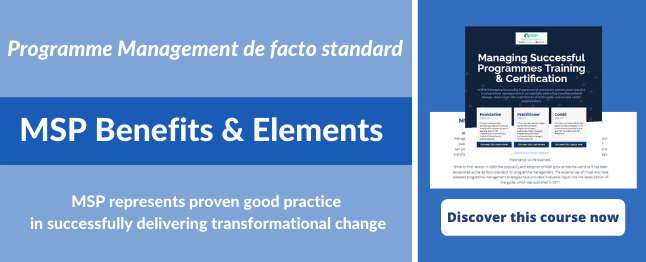
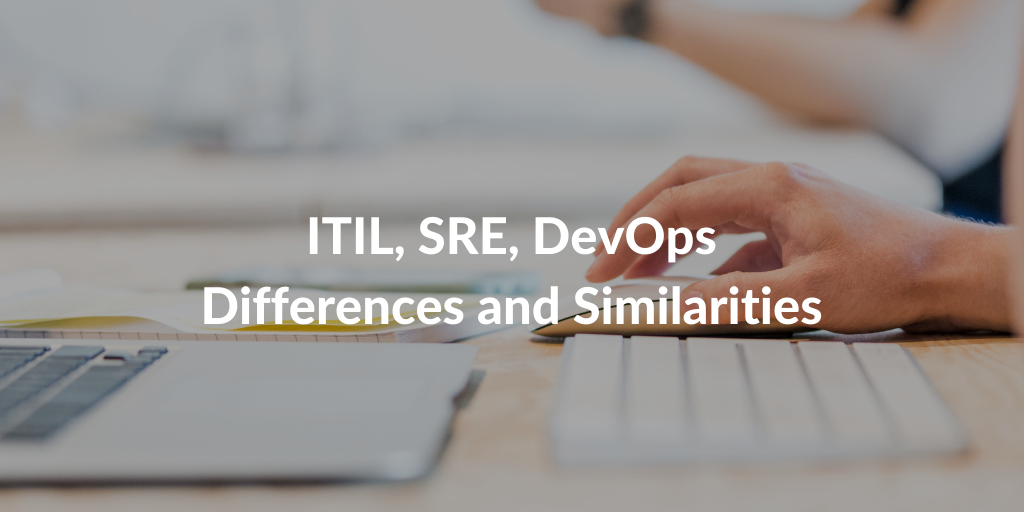
- Culture: they all introduce a collaborative and connected culture
- Value: the three best practices increase the focus on delivering value with speed and quality for stakeholders
- Automation: automation is used to reduce waste and errors made by humans.
ITIL 4
ITIL 4 is the last evolution of the service management framework from Axelos. It introduces a new Service Value System (SVS) that is supported by 7 guiding principles. The framework is now more aligned with DevOps and Agile, introducing some DevOps practices such as value streams and continuous delivery. All members of the IT organization are involved and they work together to facilitate value creation through IT-enabled services. The key components of the ITIL 4 framework are built upon the service value chain, that delivers value upon demand or opportunity through 7 guiding principles, governance, practices, and continual improvement.Focus
-service functionalities -non-functional requirements of availability, performance, security, and maintainability.Purpose
Emphasizes service quality and consistency and aims for improved stakeholders’ satisfaction through ensuring value from the perspective of the stakeholders.SRE
Site reliability engineering (SRE) is Google’s approach to service management, introduced in a book of the same name. SRE is a post-production set of practices for operating large systems at scale, with an engineering focus on operations. It introduces the role of the SRE team, which is a defined job role within organizations. The team members are software engineers who are intended to perform operation functions instead of a dedicated operations team. The reliability of production systems and therefore its users are supported by an engineer who applies SRE site principles to manage availability, latency, performance, efficiency, change management, monitoring, emergency response, and capacity planning.Focus
Non-functional requirements of availability, performance, security, and maintainability.Purpose
Emphasizes the development of systems and software that increase the reliability and performance of applications and services. SREs also have on-call responsibilities which means they need to be available to provide a service or support.DevOps
DevOps is the creation of multidisciplinary teams of Dev and Ops to replace siloed Development and Operations that work together with shared and efficient practices and tools. The key members of a DevOps team are members from the development, operations, and security team who all are working on the software lifecycle in conjunction with each other to improve software quality and speed of software development and delivery with the goal to improve customer experience. DevOps aligns with Lean principles and Agile.Focus
Speed and quality of functional (application features, etc.) and non-functional requirements of availability, performance, security, and maintainability.Purpose
Achieve improved quality while managing adequate velocity of software and services for the line of business.ITIL 4, SRE, and DevOps: similarities?
- All three methodologies encourage collaboration among the different stakeholders across IT and with the business and/or product owners.
- All three address the key topic of change management. ITIL 4 using change management governance; SRE with the concept of an “error budget” (it allows changes to be made by the SRE team until the error budget is “spent.”); DevOps teams are continually managing changes that typically are gradual.
- They are supported by a vast set of automation tools. Some tools claim to focus on DevOps, others automate key processes. The automation tool landscape is complex and continually changing.
- They also focus on continuous learning and experimentation. The skills for each methodology might change but basically, they all need a combination of automation and process skills, soft and functional skills, business, and technical skills.
ITIL 4, SRE, and DevOps: differences?
The key differences among the methodologies are in:- Team topology
- ITIL 4 does not require the team members to be on one team.
- SRE is a defined role with a defined title.
- DevOps team topologies vary, but most effective DevOps teams are a single team with the same objectives and metrics.
- Metrics
- ITIL 4: meeting of service level objectives.
- SRE: reliability of applications and services, with a focus on service level objectives and service level indicators.
- DevOps: deployment frequency and time to restore.
- Certifications
- The ITIL framework provides solid governance for IT and enterprise service management process optimization and improvements for medium and large organizations. Certifications are available at foundation, managing professional, strategic leader, and master level.
- Courses to learn and understand SRE is available from Google and others.
- DevOps certifications are available at the foundation and additional levels. The governance model is mostly done through self-organization.
When should ITIL 4, SRE, and DevOps be used?
You can adapt ITIL 4 anytime, there are no requirements of previous ITIL versions. ITIL 4 introduces and governs common best practices and language to improve customer satisfaction, service availability, and financial efficiencies. ITIL 4 also addresses organizations and people, information and technology, partners and suppliers, and value streams and processes. SRE can be adopted via the introduction of an SRE engineer as a formal team member either within a DevOps team or within a Service Management team. SRE can also be adopted by organizations that don’t have any exposure to ITIL 4 or DevOps. Key usage is when reliability is a stated goal of the organization, and the system is undergoing any growth in users, complexity, and/or the number of configuration items. A key benefit of SRE teams is the creation of self-service tools and automation scripts to address the reliability and performance of applications and services which eliminates manual work. DevOps adoption can take place anytime. Key trigger points are the demands of improved delivery speed and quality of software, products, and/or services to its stakeholders. One key benefit is that it brings cultural transformation, improves speed and quality on how software is developed and delivered. It builds on Agile software development and service management techniques and encourages the use of automation to reduce manual work of skilled individuals to focus on more value-adding tasks and activities. DevOps highlights the reliability, maintainability, and operability of software across all its team members.Conclusions
All three methodologies can co-exist together to align teams, meet stakeholder's demands, and improve the value delivered.
No matter which framework/s you choose, you need to focus on:
- A common vision and a purpose
- Infusing and managing a culture of care
- Making decisions and making them visible
- Defining metrics and measures before you start while continuing to prove the value of your efforts to your stakeholders.
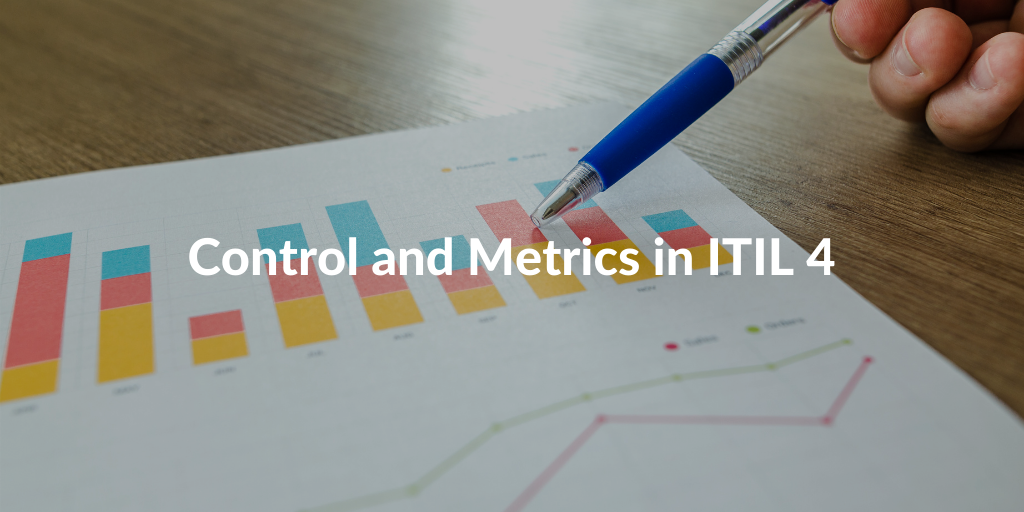
ITIL v4: Control
If we have to establish the direction, we need to define what the control is supposed to be. In ITIL 4 there is the concept of "shared government", which dispels the myth that government is linked to just the board of an organisation. Leading an organisation can be applied at many levels and each level has its own authority. In fact, each employee has a perimeter that he/she governs, has some form of authority, directs the actions to be taken and defines what the results are. ITIL emphasizes that beyond the sphere of control, people also have a sphere of influence, which means that resources can influence the decisions made by others.How to use ‘control’ according to ITIL 4?
ITIL 4 recommends to design and implement a goals cascade. This cascade must start from the goals and objectives that we set for ourselves. What follows are the definitions of the necessary indicators and the metrics that will support them.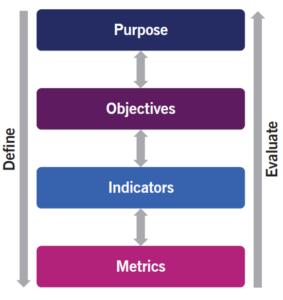
How to design a cascade
Often we start by the use of data-collection tools and collect information that is not always useful. Instead, here we start from the objectives and then define the indicators and metrics. The design of the measurement system cascades (in the image from top to bottom) is from purpose to metrics.
Of course, the measurement will then feed the indicators through the metrics, which will support the objectives and finally the ultimate goal of our needs (from bottom to top in the image).
So if it is true that it does not make sense that all decisions are taken at the same level, as it slows down the decision-making process, it is necessary to build a widespread authority. A widespread authority is created by delegating as much as possible. One way to do this is by using a metric cascade that provides the tools so that everyone can make the best decisions based on the information that he/she receives in regards to his/her own level. If the scope of control is too narrow it will always lead to pushing decisions upwards, which is something that should be avoided. If, on the other hand, the control area is too broad, there is the risk of making strategic decisions at lower organisational levels. On the one hand, restricted control leads to escalation and therefore longer times, on the other hand, less restricted control could lead to decisions with risks that are not carefully evaluated. We must therefore try to mitigate the risks by training people or providing guidelines so that decisions are aware and structured. The ITIL 4 Direct, Plan and Improve module provides the practical skills necessary to create an IT organization in continuous improvement, with a strong and effective strategic direction. ITIL DPI provides a practical method to plan and implement continuous improvement with the necessary agility. Learn more about the exam here.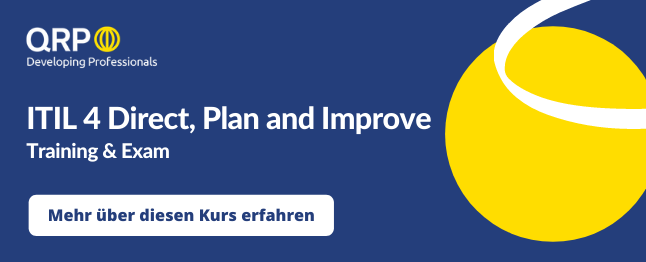 ITIL® is a registered trade mark of AXELOS Limited, used under permission of AXELOS Limited. All rights reserved.
ITIL® is a registered trade mark of AXELOS Limited, used under permission of AXELOS Limited. All rights reserved.
What is your current job, what do you do?
I have been a project director for 3 years at the head of Retail Banking in France. Previously, I held a position which consisted of developing and establishing a project management community, at the level of the Société Générale group. Here we set up certification courses for our employees in France and internationally, in particular PMP® and ACP®, and that is how I joined the PMI (Project Management Institute). Société Générale is one of the biggest partner companies of the PMI, due to its number of certified employees (+600). My role was, therefore, to conceptualize and set up professionalization courses on 3 levels:- Junior project manager
- Certification courses for project managers
- Project director
How did you come to have a career in project management?
I own a master's degree in chemistry but due to the economic context of the time and the arrival of the euro, I was recruited into the banking sector as a programmer analyst. In those days, service companies were looking for scientific profiles because there were not enough computer scientists available. A few years later, I entered the world of project management, as an MOA project manager. I learned a lot from the service company, where I worked for over ten years. It allowed me to acquire a very diverse knowledge, to see a lot of customers, many ways of working and adaptability. In 2007 I responded to an offer from Crédit du Nord for a program PMO position. During the 5 years I worked here, I started to develop my expertise in PMO program and project management. Subsequently, I joined Société Générale. In 2016 we organized events in partnership with PMI and Microsoft, where I met a member of PMI who wanted to organize a national forum in Paris. He was looking to put together a team to set up the project, including an assistant, and I accepted the challenge. I was in charge of the second edition in 2017 and a year later I joined the board of directors of the PMI chapter France, with sponsorship and national projects as a mission. I was elected president of PMI France last year and re-elected this year. I am the second woman in France, elected president of a chapter and the first at the national level.Where did you get the idea of launching the Women by PMI initiative?
Statistics show us that only 25% of people involved with PMI are women (20% worldwide). We understood there was a need to create the Women by PMI project and we did so after very interesting discussions with our partner companies. The idea came from one of our volunteers working within the Schlumberger group. In view of the figures and her experience, she had the idea of creating a community of women at PMI, like the one at Schlumberger. The community focuses on Women in order to educate them about project management, PMP training and certifications.Why do you think the percentage of women is so low?
Project management, wrongly, is often associated with IT since job openings as a project manager are often related to IT departments. IT departments are mostly made up of more men than women. However, the world of project management is not limited to IT and encompasses a wide range of sectors where male and female are equally divided. The Women by PMI project is precisely the opportunity for us to spread information and show that project management is not only linked to the information system and IT. There is just as much need for project management in a business direction, in real estate, marketing, finance, ... I had the opportunity to interact with a young woman who felt that she was not concerned with project management in her daily life since she has the role of Product Owner. In reality, it is quite the opposite, the Product Owner is an integral part of the project. We, therefore, wish to redefine the definition of project management to clarify the discipline and all that it encompasses. I think there are a lot more women who do project management on a daily basis but are not necessarily aware of it. By informing professionals, men and women, and by clearly defining project management, we could easily increase these statistics.What does the Women in PMI project entail precisely?
Through this initiative we want to:- Develop and professionalize certain companies which to date do not have knowledge of PMI and what it can provide at the corporate level.
- Popularize what project management is, the professions and what it encompasses, in order to facilitate the understanding and recognition of professionals.
- Inspiring thousands of women.
- Increase the PMI community, both in terms of professionals and partner companies, which I would like to point out are absolutely heterogeneous, from all profiles and sectors.
What about the practical side of the project?
Our aim is to further spread the professionalization of project management, through certifications, training courses and also mentoring. The focus is mostly, but not limited, to women. We organize a lot of initiatives, networking events, PM coffee to enable women to create and develop their own network, either with partner companies or among themselves. We held an event in November 2019, in partnership with Schlumberger for the launch of the initiative, as well as two themed networking events before the lockdown, which were all very successful. Unfortunately, all our initiatives since February have been cancelled.How can I join the initiative?
You can join the initiative as a member: you can register for online events as soon as they occur and participate in face-to-face events. The COVID-19 crisis has slowed the development of the initiative, but as soon as the situation allows it, we fully intend to resume our efforts. We would like to welcome new volunteers to support us and actively participate in the development of Women by PMI. This project is a real added value, beneficial not only for women but for the entire project management community and for all the people who do project management thinking of not doing it. We want to support professionals in their development, particularly through the mentoring project. Indeed, being and feeling accompanied by a senior project management mentor is a real advantage. What is extraordinary about this initiative is the meeting and mixing of all these women who share varied experiences and skills, whether they are members or not, volunteers or not, there is an enormous wealth that emerges from the diversity of the community, however intercultural it may be. To all the women of the community: know that you are welcome! Fabiola Maisonnier Project Manager PMI France, Olivia Le Jeune President PMI France, François Delignette Sponsor of the initiativeOlivia Le Jeune
 Olivia is project director for the transformation of the operational model of French Retail Banking and President of PMI France.
Olivia is project director for the transformation of the operational model of French Retail Banking and President of PMI France.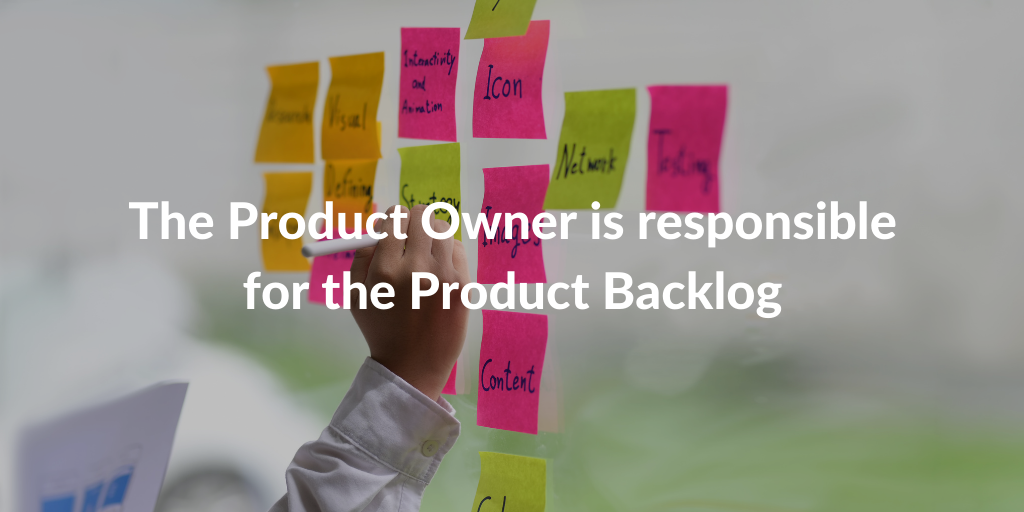
- Clearly expressing Product Backlog items
- Ordering the items in the backlog to best achieve goals
- Optimizing the value of the work of the Development Team
- Ensuring that the Product Backlog is visible, transparent and clear to all and that it shows what the Scrum Team will work on next
- Ensuring the Development Team understands items in the Product Backlog to the level needed.
The Responsibilities of the Scrum Product Owner
The Product Owner represents the interests of the stakeholder community to the Scrum Team. He/she is responsible for:- Ensuring clear communication of product or service functionality requirements to the Scrum Team
- Defining Acceptance Criteria, and ensuring those criteria are met.
- Define the Project Vision
- Help create the Project Charter and Project Budget
- Identify Stakeholder(s)
- Help determine Scrum Master and Scrum Team members
- Help develop a Collaboration Plan
- Help develop the Team Building Plan with Scrum Master(s)
- Create Epic(s) and Personas
- Prioritize the items in the Product Backlog
- Define Done Criteria
- Create a Release Planning Schedule
- Help create User Stories
- Define Acceptance Criteria for every User Story
- Clarify User Stories
- Work with Scrum Team to commit User Stories
- Explain User Stories to the Scrum Team while creating the Task List
- Provide guidance and clarification to the Scrum Team in estimating effort for tasks
- Clarify requirements to the Scrum Team while creating the Sprint Backlog
- Clarify business requirements to the Scrum Team
- Accept/Reject Deliverables
- Provide necessary feedback to Scrum Master and Scrum Teams
- Update Release Plan and Prioritized Product Backlog
- Help deploy Product Releases and coordinates this with the customer
- Participate in Retrospective Sprint Meetings
- Secure the initial and ongoing financial resources for the project.
The necessary skills for being a Scrum Product Owner
The Scrum Product Owner should be a Scrum Expert, knowing Scrum processes. He/she also must have business domain knowledge and excellent communication skills. Other important soft skills, highlighted by the Scrum Guide are:- Ability to handle uncertainties
- Negotiation Skills
- Approachable
- Proactive
- Decisive
- Pragmatic
- Goal-Oriented
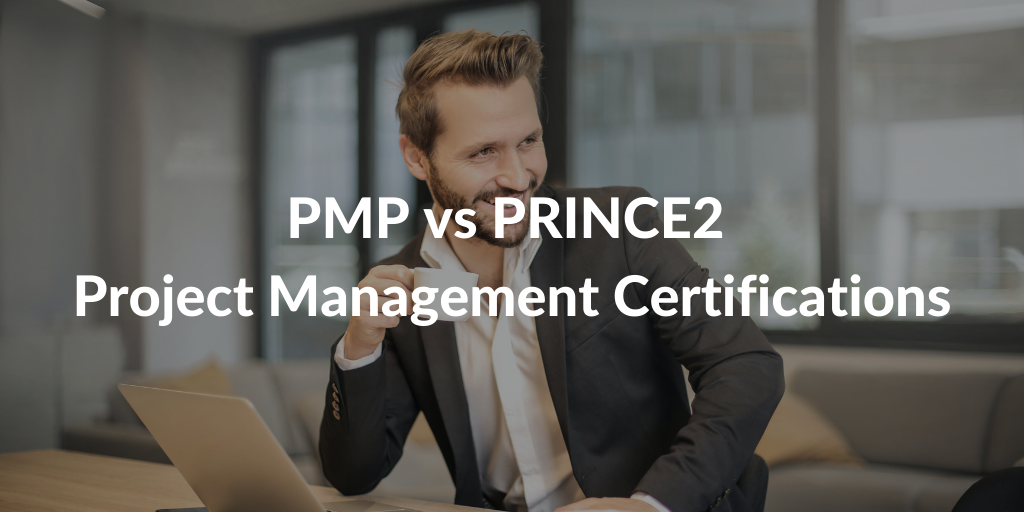
PRINCE2 (Projects In Control Environment)
PRINCE2 is an integrated project management method that provides a set of processes and issues applicable to the management of a project from start to finish. PRINCE2 provides a model of what needs to be done, who needs to do it, and when it needs to be finished.
PRINCE2 was developed by the UK Office of Government Commerce (OGC) in 1996 and is a registered trademark of Axelos. The current version is the PRINCE2 6th Edition.PMP (Project Management Professional)
PMP, which stands for Project Management Professional, is a standard, a "body of knowledge" (PMBOK). It contains "everything" you need to know and do in Project Management. PMP covers the broad spectrum of project management skills and techniques that Project Managers may need to apply, such as leadership and negotiation. The certification was developed and is issued by the Project Management Institute (PMI), an authoritative body in the field of project management. Interested to learn more about PMP? Register for our FREE webinar. Xavier Heusdens will explain why it is worth it to invest in the PMP certification.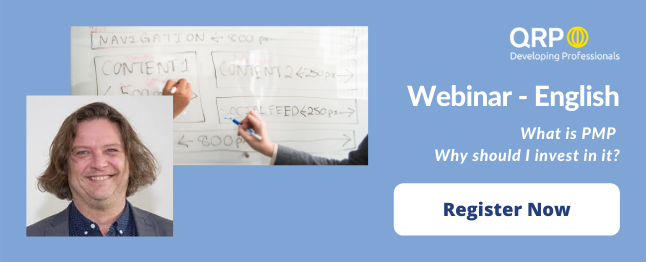
The differences between PRINCE2 and PMP
The key difference is that while PRINCE2 is a methodology, PMP is considered a body of knowledge. The PRINCE2 method can guide and tell you how to proceed with your projects. To help you achieve your goals, it also provides templates that you can use or adapt to your projects and the needs of your organization. PMP on the other hand, provides a framework, a body of project management knowledge. It can provide you with a range of techniques and tools that you can apply according to your needs. This means that PMP certification certifies the mastery of Project Management skills and techniques, while the PRINCE2 certification certifies the ability to manage the project in a controlled manner following the PRINCE2 method. An example. To create a plan in PRINCE2 it is necessary to estimate the activities - there are various techniques that can be applied depending on the project, but PRINCE2 does not say what these techniques are. The PMBOK instead offers an explanation and analysis of the range of estimation techniques available so that you can choose what fits best for your project.PMP and PRINCE2 comparison
Applicability
Both certifications can be applied to any type of project. They are both standards and can be adapted or tailored as needed.Importance and diffusion
Both are certainly two important and prestigious certifications, recognized worldwide. In general, PRINCE2 is more widespread in Europe and PMP in The United States of America. Both certifications can be required for participation in public tenders. On a more individual level, both can also improve and influence the CV and career path of a professional.Levels of certification and prerequisites
PRINCE2 consists of two levels: PRINCE2 Foundation and PRINCE2 Practitioner. The Foundation level contains the theoretical part of the method, so it serves to have a general understanding of the methodology. There are no prerequisites for this level, but experience in project management is recommended. The Foundation certification does not expire and is a prerequisite for accessing the next level, the Practitioner. The Practitioner level gives the possibility to understand how to apply the method in practice. The Practitioner certification lasts for 3 years. In order to access it, you must have one of the following certifications:- PRINCE2 Foundation,
- PMP,
- CAPM,
- IPMA.
- for those in possession of a degree, it is necessary to have achieved project management work experience for at least 4,500 hours over a minimum of 3 years
- for those in possession of a high school diploma, having achieved project management work experience for at least 7,500 hours over a minimum of 5 years.







